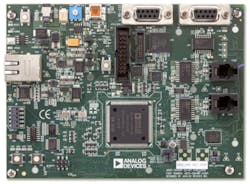Tackling PV Inverter and Electric Motor Challenges
World net electricity generation will increase 93% from 20.2 trillion kWhr in 2010 to 39.0 trillion kWhr in 2040, according to the U.S. Energy Information Administration, which adds that electricity is the world’s fastest-growing form of delivered energy. World electricity delivered to end users will rise by 2.2% per year from 2010 to 2040, the EIA said, as compared with average growth of 1.4% per year for all delivered energy sources.1
As for where that electricity goes, electric motors and the systems they drive are the single largest users of electric power, consuming more than twice as much as lighting. This is according to the International Energy Agency, which says electric motors and systems consume between 43% and 46% of all globally generated electricity.2
On another front, the solar photovoltaic (PV) market is poised to grow at a healthy 10.5% compound annual growth rate (CAGR) to reach $155 billion in 2018, according to Lux Research. In the most likely scenario, the PV market will grow at a modest clip to 35 GW in 2013 before rapidly ramping up to 61.7 GW in 2018, the firm said.
Mixed-Signal Control Processor
Tim Resker, product marketing manager at Analog Devices, cited such statistics as representing forces that have driven one of his company’s recent innovations—the ADSP-CM40x mixed-signal control processor. According to Resker, the control processor integrates an embedded dual 16-bit A/D converter with up to 14 bits of accuracy together with a 240-MHz floating-point ARM Cortex-M4 processor core.
Resker cited several global trends that led to the development of the ADSP-CM40x. Increasing labor costs are driving the growth of factory automation and robotics, he said, and manufacturers are demanding higher performance and better reliability in their motor and control systems to achieve lower cost of ownership. The shift from analog to digital motor control, he said, is enabling higher precision. With respect to reliability, he said one estimate indicates that $197 billion is spent globally on electric-motor maintenance due to improperly controlled motors. In addition, governments are driving requirements for higher system efficiencies and forcing a move to permanent-magnet motors.
And finally, Resker said, “The move toward distributed generation with sustainable technologies is driving increasingly innovative inverter designs.” Such designs will help achieve grid parity. Solar PV, he added, has become the largest source of new-generation capacity added to the global electricity grid—with a cumulative installation base of 100 GW—and is set to become the fastest growing source of renewable energy generation over the next decade. Ever more stringent grid compliance requirements, coupled with faster power control loops fueled by the emergence of GaN (gallium nitride) and SiC (silicon carbide) power switching technologies, are combining to enable significant performance and cost improvements in the next generation of solar PV inverter topologies.
In response to these trends, Resker said, equipment manufacturers require highly accurate, closed-loop control in servo, motor-drive, solar PV inverter, and other embedded industrial applications to improve the energy efficiency and performance of their products. The precision analog conversion of the ADSP-CM40x, he said, helps achieve these goals.
He described the ADSP-CM40x series as the first of a new generation of mixed-signal control processors for precision control applications. In addition to its analog conversion performance and 380-ns conversion speeds, the ADSP-CM40x provides features such as a full sinc filter implementation to interface directly to isolated sigma-delta modulators (AD7400A/AD7401A), which are used in shunt-based current-sensing system architectures. The availability of an on-chip sinc filter eliminates the cost and engineering resources required to implement that function in an FPGA.
Of particular note for solar-inverter applications, Resker said, the device includes a harmonic analysis engine—an onboard independent hardware analyzer that offers real-time grid-injected monitoring while measuring spectral purity and enabling power-factor correction. Prices for the ADSP-CM40x start at $11.89 for engineering-grade samples. Evaluation boards (Figure 1) begin at $275 and include the Segger J-Link Lite Emulator.
Figure 1. ADSP-CM40x Mixed-Signal Control Processor Evaluation Board
Courtesy of Analog Devices
Beyond Silicon
Resker said that customers expect more system-level solutions as opposed to just silicon components. Analog Devices, he said, offers complete signal-chain development and deployment with products like its iCoupler portfolio. The company also supports third-party engineering service firms such as Boston Engineering and provides compatibility with software tools from companies including IAR Systems and MathWorks.
As an example of software support, Resker said, Analog Devices is enhancing system development value by bringing designs from simulation to productized code implementation in an embedded platform through support of MathWorks’ ARM Cortex-M optimized embedded coder and tool suites.
“Through optimized code generation, device drivers, and compiler suites, Analog Devices’ new ADSP-CM40x series enables engineers to plug their designs directly into an environment for model-based design using MATLAB and Simulink software, streamlining the workflow from system modeling to controller deployment to verification and certification,” said Tom Erkkinen, products manager, MathWorks, in a press release. “This structure defines a complete model-based development platform, allowing engineers to focus on faster development of more efficient systems.”
References
1. “International Energy Outlook 2013,” U.S. Energy Information Administration, July 25, 2013.
2. Waide, P. and Brunner, C.U., Energy-Efficiency Policy Opportunities for Electric Motor-Driven Systems, International Energy Agency, Working Paper, 2011.

